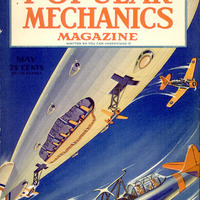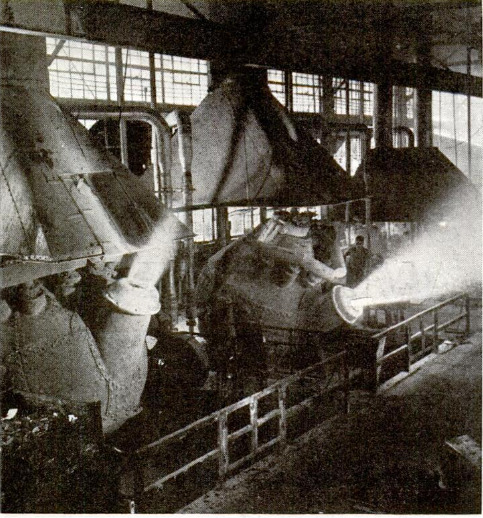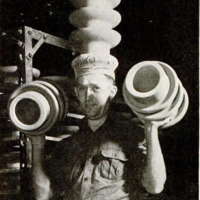IN SEARCHING for substitutes for the many materials now being poured into the funnel of our all-out effort against our enemies, American scientists are discovering many new things so good they probably will be preferred after the war to materials for which they are now pinch-hitting. For instance, we might consider the “Cinderella” metal, molybdenum, new plastics that are taking over some of the jobs once performed by metals, and the revelation through research of new ways to improve such materials as steel, porcelain and metal platings. At present the all-out search for substitutes seems like a mad scramble for things that will do in a pinch. For example, national defense and now war priorities have forced the substituter in some cases to turn to such rare metals as silver. But out of this scramble are bound to come lasting benefits to America, just as the emergency of 1914-1918 produced many of our most useful alloy steels and the light, strong alloys of aluminum. Because America has almost a world monopoly on molybdenum, this metal seems destined to play a leading role in a new drama of steel making. This country is well blessed with resources of the base metals - iron, lead, zinc, aluminum and copper. But for nickel, chromium, manganese and tungsten - used as alloying elements added to iron to produce steel of strength, hardness or workability - and for tin - used in solder, bronze alloys and met in an effort to maintain, as far as possible, the manufacture of its non-war products, metallurgists at Westinghouse have been searching for ways to utilize molybdenum instead of the priority-bound metals. Since the United States produces nearly 90 percent of the world’s molybdenum, it does not seem likely that this country will ever suffer from a scarcity of this metal. The largest molybdenum mine is in Colorado and there are other deposits in Utah and Arizona. The metal is a newcomer to the production line, partly because our great stores of it were discovered in comparatively recent years and partly because of great difficulties which metallurgists experienced at first in learning how to produce and heat-treat alloys containing molybdenum. At Westinghouse, and elsewhere, molybdenum is being employed in place of nickel, which has been used for many years as the strengthening element in steel for shafts, bolts, gears and other highly stressed parts of such machines as motors and generators. Because nickel steel is now in great demand for shells, the newer molybdenum steels are substituted where possible in making these tough parts of machinery. Similarly, when tungsten was added to the list of strategic materials, a substitute was needed for high-speed tool steel, containing about 18 percent of this metal. The substitute was found and now various sections of Westinghouse plants are using tools made of molybdenum steel, containing only a small amount of tungsten. The new alloy is equal in quality to its predecessor and is less expensive - indicating that it may replace for all time the straight tungsten steel for many purposes where it was formerly considered indispensable. Nickel and chromium, as well as tin and zinc, are among the favorite plating materials, which protect steel and other metals from rust, corrosion and tarnish. As these metals went on the priority list it became necessary to find substitutes. Then substitutes for substitutes had to be found. For example, the cover of one type of electric roaster was originally made of aluminum. First, plans were made to substitute stainless steel (containing chromium), but before these plans were put into effect, it appeared that stainless steel would become scarce and new plans were laid for the use of chromium plating over nickel plating. Then nickel and chromium priorities ended those plans. Now, as coverless roasters pile up in warehouses, engineers are working on an enameled steel cover. In a few cases, engineers have resorted to the use of silver, one of the very few metals not affected by priorities regulations. A stainless steel part of a thermostat has been replaced by silver. Ordinary paint has partly replaced galvanizing (zinc coating). Westinghouse has made many substitutions for aluminum. Nearly every bit of this metal has been removed from electric refrigerators. Ice-cube trays are now made of rubber. Glass and enameled iron have been substituted for aluminum in dishes, trays and other parts. Broiler pans and deep-well cookers on new ranges are made of enameled iron. Waffle-iron grids are made of cast iron. Plastics have taken the place of aluminum in washing-machine agitators, vacuum-cleaner nozzles and parts of other appliances. A permanent change in the construction of screw bases for electric lamps is seen in the substitution of brass-plated steel for solid brass. Engineers say the substitute is less expensive and appears to be just as good. For wires that lead from tiie lamp base to the filament inside the bulb, nickel-plated steel has taken the place of solid nickel. Strategic metals also play a part in the manufacture of porcelain - the material used for electrical insulation of power lines and in electric switches and transformers. Porcelain is made by molding a mixture of special clays into desired shapes, coating them with a glaze and baking at high temperatures in a kiln. This glaze, which appears as a hard, glasslike coating on the finished product, is applied as a watery mixture of many materials, including compounds of nickel, zinc and other metals. Engineers at Westinghouse started a search for a glaze without these strategic materials. When they succeeded a few months ago, they found they had a substance superior in many ways to the old. The new glaze increased the strength of porcelain 100 percent, producing a better insulator and one easier to manufacture and more resistant to weather. Our research chemists have been working on an idea for an entirely new type of plastic. The material originally was intended for use in making parts of household appliances, to do away with sheet steel and thick walls of insulating materials. But because this same plastic promises to be useful to the United States Army, the research work has been pushed faster than planned, with good results. So far plastics have been of two general types. One is the molded type which can be poured or pressed into molds to form such odd shapes as ash trays, fountain pens and small radio cabinets. But this type lacks the strength needed in some applications. The other type is known as laminated plastic. It is made by piling up layers of paper, cloth or other sheet material, impregnating them with resin and then hardening the resin under pressure and heat. This type has strength - sometimes equaling that of steel, weight for weight - but it is impossible to form it into complex shapes with sharp corners and other irregularities. The new Westinghouse plastic is understood to combine the advantages of these two types. It is called a preformed plastic, because a mixture of wet pulp and resin is first formed in the general shape of the finished product. Then the piece is baked under pressure to harden the resin. The preformed plastic has the strength of the laminated plastic and the moldability of the molded type. Our chemists are now working out methods to use this preformed plastic in several military items. One example is in the windshields, or streamline noses, of anti-tank shells which are now made of aluminum. These windshields must be light-weight to maintain balance of the shell, yet strong enough to prevent their flying apart as the shell whirls through the air at tens of thousands of revolutions per minute. Another suggested use for the new plastic is in a new, two-part army helmet. The inner part of this helmet is to be made of preformed plastic, which is strong but lightweight. This part could be worn by the soldier during ordinary field operations. During battle, the other part, made of steel, could be slipped on over the plastic part to give greater protection. In another unusual development, porcelain is being used as a substitute for phenolic plastics. Phenolic plastics are compounded primarily from formaldehyde, phenols and cresols, all of which are in demand by our armed forces. Porcelain is being substituted satisfactorily; in many applications it has proved better than plastics. It lends itself to the manufacture of parts for ignition systems, thermostats for industrial furnaces and even stoppers for perfume bottles. Water-cooler parts formerly made of aluminum are being produced from this same type of porcelain, which also finds use as a substitute for hard rubber in making valve seats. From these few examples, we can see that the war is bringing about the development of new products and processes that may prove better than any we ever had before.
 Popular Mechanics, vol. 77, n. 5, 1942
Popular Mechanics, vol. 77, n. 5, 1942





